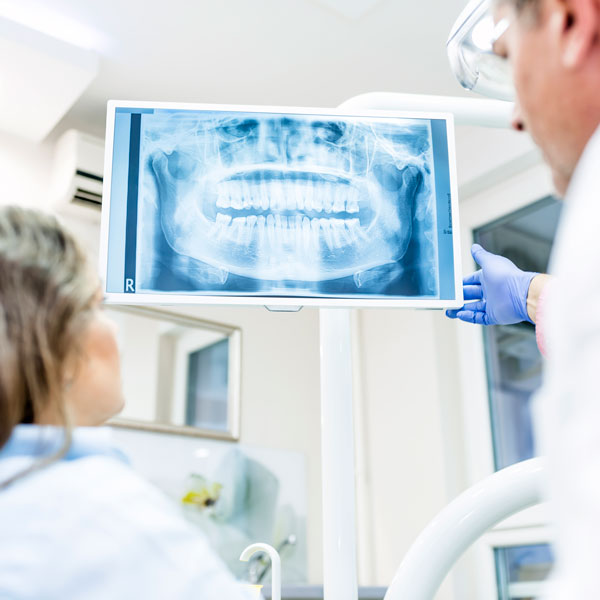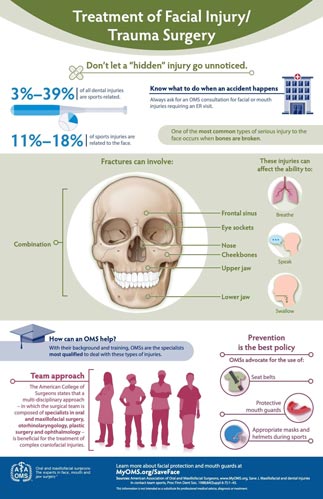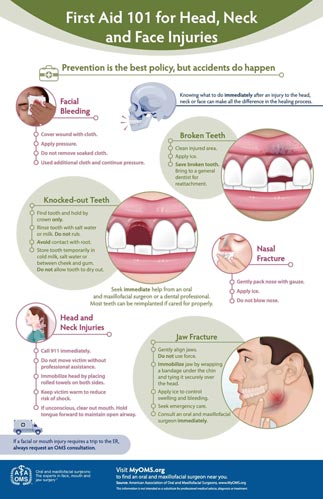Facial Trauma
Facial Injuries
Maxillofacial injuries, also referred to as facial trauma, include any injury to the mouth, face, and jaw. Oral and maxillofacial surgeons, the surgical specialists of the dental profession, are the experts in treating and repairing injuries to the mouth, face, and jaw, including fractures and soft tissue injuries.

Causes of Facial Trauma
There are numerous causes of facial trauma, with the most common being motor vehicle accidents, accidental falls, sports injuries, interpersonal violence, and on-the-job mishaps. Types of facial injuries can range from simple lacerations and fractures to crushing injuries of the face or total avulsion (forceable separation) of facial structures.
Facial Trauma Treatments
If a person is unconscious, disoriented, nauseated, dizzy or otherwise incapacitated, call 911 immediately. If these symptoms are not present but the injury is severe or you are uncertain about its severity, take the person to the nearest hospital emergency room as quickly as possible.
Soft Tissue Injuries
When soft tissue injuries, such as lacerations, occur on the face, they are repaired by suturing.
Facial Fractures
Facial bone fractures are treated in a manner similar to fractures in other parts of the body. The specific form of treatment is determined by various factors, including the location and severity of the fracture, as well as the age and general health of the patient. When an arm or a leg is fractured, a cast is often utilized to stabilize the bone to allow for proper healing. Since a cast cannot be placed on the face, other methods of stabilizing facial fractures are utilized.
Certain types of fractures of the jaw are best treated and stabilized by the surgical placement of small plates and screws at the involved site. This technique is known as “rigid fixation” of a fracture. The development and use of rigid fixation has profoundly improved the recovery period for many patients, allowing them to return to normal function more quickly.
Tooth Fractures
Isolated injuries to the teeth are quite common and may require the expertise of various dental specialists. Oral surgeons are usually involved in treating fractures in the supporting bone or in replanting teeth that have been displaced or knocked out. These types of injuries are treated by a form of splinting, either through stabilizing by wiring or bonding teeth together.
If a tooth is knocked out, it should be immediately placed back inside the mouth, alongside the cheek. Otherwise, the next best option is storing the tooth in milk. The sooner the tooth is reinserted into the dental socket, the better the chance it will survive. If injured teeth cannot be saved or repaired, dental implants are often utilized as replacements for missing teeth.
Facial Trauma Prevention
Although facial injuries cannot necessarily be avoided in certain circumstances, there are steps that you can take to mitigate your risk of developing injuries to the mouth, face, and jaw. Given that automobile accidents and sports injuries are common causes of facial trauma, oral and maxillofacial surgeons advocate the use of seat belts and protective mouth guards, masks, and helmets for everyone who participates in athletic pursuits.
Helmets with face guards and mouth guards should be worn. Many of the helmets manufactured for younger players have plastic face guards that can be bent back into the face and cause injury. It is recommended that these plastic guards be replaced by carbon steel wire guards.
A catcher should always wear a mask. Batting helmets with a clear, molded plastic face guard are now available. These can also be worn while fielding.
Many ice hockey players are beginning to wear cage-like face guards attached to their helmets. These are superior to the hard plastic face masks worn by goalies, as the face guard and the helmet take the pressure of a blow instead of the face. For extra protection, both face and mouth guards – including external mouth guards made of hard plastic and secured with straps – can be worn.
More and more high school athletic associations require wrestlers to wear headgear. A strap with a chin cup holds the gear in place and helps steady the jaw. Recently, face masks have been developed for wrestlers, who should also wear mouth guards.
Mouth guards are mandatory in this sport. A new, pacifier-like mouth guard for boxers has been designed with a thicker front, including air holes to aid breathing.
Hard plastic helmets (resembling baseball batting helmets) with wire cage face masks are manufactured for this sport.
It is recommended that athletes in this sport wear mouth guards. Goalies can receive extra protection by wearing lacrosse helmets.
Soccer players should wear mouth guards for protection. Goalies are also advised to wear helmets.
All riders should wear lightweight bike helmets to protect their heads.
Bike helmets are recommended for those who ride two-wheeled scooters and skateboards.
Lightweight helmets are available to protect the maxillofacial area in the event of a fall or crash.
A helmet and mouth guard are recommended for horseback riding, particularly if the rider is traveling cross-country or plans to jump the horse.
Participants in these sports should be fitted with mouth guards.
A Word About Mouth Guards
New synthetic materials and advances in the engineering and design of mouth guards have made them sturdier yet lightweight enough to allow the wearer to breathe easily. Mouth guards can vary from the inexpensive “boil and bite” models to custom-fabricated guards made by dentists, which can be adapted to the sport.
A mouth protector should be evaluated from the standpoint of retention, comfort, ability to speak and breathe, tear-resistance and protection provided to the teeth, gums and lips.
There are five criteria to consider when being fitted for a mouth protector. The device should be:
- Fitted so that it does not misalign the jaw and throw off the bite
- Lightweight
- Strong
- Easy to clean
- Should cover the upper and/or lower teeth and gums
By encouraging sports enthusiasts at every level of play to wear mouth guards and other protective equipment, oral and maxillofacial surgeons hope to help change the “face” of sports.


